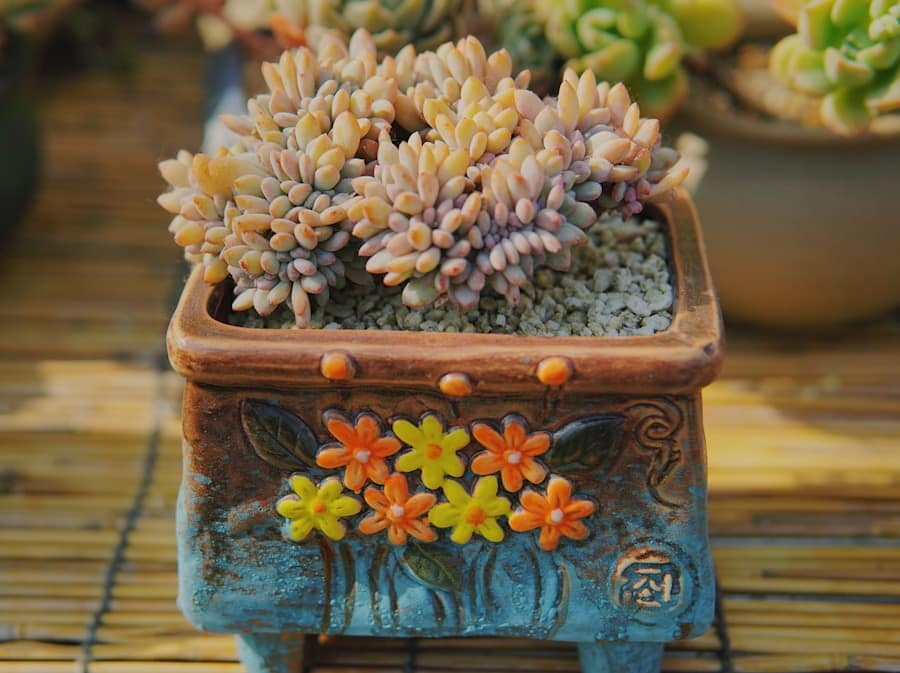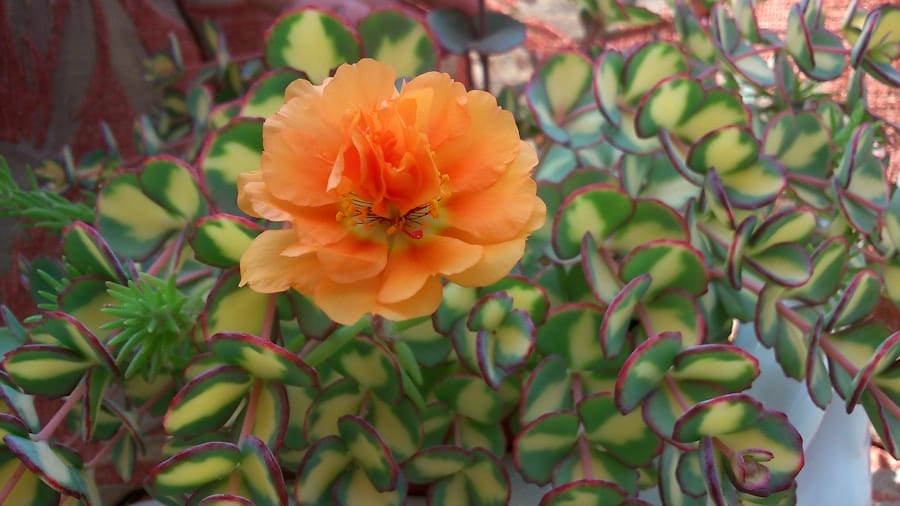As I delve into the world of succulent plants, I find myself particularly captivated by the vibrant orange flower succulent plants. These unique specimens not only add a splash of color to any garden or indoor space but also embody the resilience and beauty that succulents are known for. With their fleshy leaves and striking blooms, orange flower succulents are a delightful addition to my collection.
They serve as a reminder of nature’s artistry, showcasing how even in arid conditions, life can flourish in the most unexpected ways. The allure of orange flower succulents lies not just in their aesthetic appeal but also in their adaptability. These plants thrive in various environments, making them suitable for both novice and experienced gardeners.
As I explore the different species and varieties, I am continually amazed by their diverse shapes, sizes, and growth habits. From the compact rosettes to the sprawling ground covers, each plant tells its own story, inviting me to learn more about their care and cultivation. Visit Our Site at https://chikusgarden.com/ for more information.
Key Takeaways
- Orange flower succulent plants are a beautiful addition to any home or garden, with their vibrant blooms and unique foliage.
- When choosing a location for orange flower succulent plants, it’s important to consider their need for plenty of sunlight and well-draining soil.
- Proper watering and drainage are crucial for the health of orange flower succulent plants, as they are prone to root rot if overwatered.
- Fertilizing and using the right soil mix are essential for the growth and development of orange flower succulent plants.
- Pruning and propagation are important tasks for maintaining the health and appearance of orange flower succulent plants, while also controlling their size and shape.
Choosing the Right Location for Orange Flower Succulent Plants
The Importance of Indirect Sunlight
When I first introduced them to my home, I placed them on a windowsill that received ample light throughout the day. However, I quickly realized that too much direct sunlight could scorch their delicate leaves. Now, I carefully observe how the light shifts throughout the day, ensuring that my succulents receive just the right amount of brightness without being overwhelmed.
I often position them in areas where they can benefit from gentle breezes, which helps prevent mold and rot. Whether it’s on a patio or a well-ventilated room, I make it a point to keep them in spaces that allow for airflow.
Achieving Optimal Growth
This attention to detail has made a significant difference in their growth and overall vitality.
Proper Watering and Drainage for Orange Flower Succulent Plants

Watering my orange flower succulent plants has been a learning experience filled with trial and error. Initially, I struggled with finding the right balance; too much water led to root rot, while too little left them parched. Over time, I’ve come to understand that these plants prefer a deep soak followed by a thorough drying period.
I now wait until the soil is completely dry before giving them another drink, ensuring that their roots remain healthy and strong. Equally important is the drainage system I’ve established for my succulents. I’ve learned that using pots with drainage holes is essential to prevent water from pooling at the bottom.
Additionally, I often mix potting soil with sand or perlite to enhance drainage further. This combination allows excess water to escape while retaining just enough moisture for my orange flower succulents to thrive. By paying close attention to both watering and drainage, I’ve seen my plants flourish like never before.
Fertilizing and Soil Requirements for Orange Flower Succulent Plants
| Soil Type | Well-draining, sandy soil |
|---|---|
| Fertilizing Frequency | Every 2-4 weeks during growing season |
| Fertilizer Type | Balanced liquid fertilizer (10-10-10) |
| Soil pH | 6.0-7.0 |
| Additional Soil Requirements | May benefit from occasional top dressing with compost |
When it comes to fertilizing my orange flower succulent plants, I’ve adopted a minimalist approach. These resilient plants don’t require heavy feeding; instead, they thrive on a balanced fertilizer diluted to half strength during the growing season. I typically apply this fertilizer every four to six weeks in spring and summer, which seems to provide just the right nutrients without overwhelming them.
This careful balance has resulted in vibrant blooms and healthy foliage. The soil I use is equally important in supporting the growth of my succulents. A well-draining cactus mix has become my go-to choice, as it provides the necessary aeration while retaining some moisture.
Occasionally, I mix in organic compost to enrich the soil further, ensuring that my orange flower succulents have access to essential nutrients. By focusing on both fertilization and soil quality, I’ve created an environment where my plants can truly thrive.
Pruning and Propagation of Orange Flower Succulent Plants
Pruning has become an essential part of my routine when caring for orange flower succulent plants. I’ve learned that regular trimming not only helps maintain their shape but also encourages new growth. When I notice any dead or wilted leaves, I promptly remove them to prevent any potential disease from spreading.
This practice has not only improved the overall appearance of my plants but has also contributed to their health and vitality. Propagation has also piqued my interest as I’ve experimented with various methods to expand my collection. One of my favorite techniques involves taking leaf cuttings from healthy plants and allowing them to callous over before placing them in soil.
Watching these cuttings develop roots and eventually grow into new plants is incredibly rewarding. Each successful propagation feels like a small victory, adding to my passion for these beautiful orange flower succulents.
Dealing with Pests and Diseases in Orange Flower Succulent Plants

Despite my best efforts, I’ve encountered pests and diseases that threaten my orange flower succulent plants. Aphids and mealybugs have been particularly troublesome at times, but I’ve learned effective strategies for managing these unwelcome visitors. Regularly inspecting my plants allows me to catch infestations early on; when I do spot pests, I often use a gentle soap solution or neem oil as a natural remedy.
This approach minimizes harm to the plants while effectively addressing the issue.
Maintaining proper watering practices has been crucial in preventing these issues from arising.
If I notice any signs of distress—such as yellowing leaves or mushy stems—I act quickly by adjusting my watering schedule or repotting the affected plant into fresh soil. By staying proactive and informed about potential threats, I’ve managed to keep my orange flower succulents healthy and thriving.
Winter Care for Orange Flower Succulent Plants
As winter approaches, I’ve learned that caring for my orange flower succulent plants requires special attention. These plants are not frost-tolerant, so I’ve made it a priority to bring them indoors before temperatures drop too low. Once inside, I ensure they are placed in a bright location where they can continue to receive adequate light during the shorter days of winter.
During this season, I’ve adjusted my watering routine as well. With lower light levels and cooler temperatures, my succulents require less water than they do in warmer months. I’ve found that allowing the soil to dry out more thoroughly between waterings helps prevent any winter-related issues such as rot or mold growth.
By being mindful of their needs during this time, I’ve successfully kept my orange flower succulents healthy through the winter months.
Enjoying the Beauty of Orange Flower Succulent Plants in Your Home or Garden
The joy of cultivating orange flower succulent plants extends beyond their care; it also lies in how they enhance my living space. Whether displayed on a sunny windowsill or arranged in a vibrant garden bed, these plants bring life and color into my home. Their unique shapes and striking blooms serve as conversation starters when guests visit, allowing me to share my passion for gardening.
I often find myself taking moments throughout the day to appreciate their beauty—watching how sunlight dances on their leaves or admiring the intricate details of their flowers. Each plant seems to have its own personality, contributing to the overall ambiance of my home or garden. As I continue to nurture these stunning specimens, I am reminded of the simple pleasures that come from connecting with nature and creating a space filled with life and color.
If you are interested in learning more about caring for unique and beautiful plants like the orange flower succulent, you may also want to check out this article on growing stunning trees with purple flowers. This article provides helpful tips and information on how to cultivate these eye-catching trees in your garden.
FAQs
What is an orange flower succulent plant?
An orange flower succulent plant is a type of succulent that produces vibrant orange flowers. It is a low-maintenance plant that is well-suited for indoor and outdoor environments.
What are the characteristics of an orange flower succulent plant?
Orange flower succulent plants typically have fleshy, green leaves and produce bright orange flowers. They are drought-tolerant and require minimal watering, making them ideal for arid climates.
How do you care for an orange flower succulent plant?
To care for an orange flower succulent plant, it is important to provide well-draining soil, ample sunlight, and infrequent watering. These plants thrive in dry conditions and should be protected from frost in colder climates.
Where can you find orange flower succulent plants?
Orange flower succulent plants can be found at nurseries, garden centers, and online plant retailers. They are popular choices for succulent gardens, rock gardens, and container plantings.
Are orange flower succulent plants toxic to pets?
Orange flower succulent plants are generally non-toxic to pets, but it is always best to keep them out of reach of curious animals. If ingested, they may cause mild gastrointestinal discomfort in pets.

